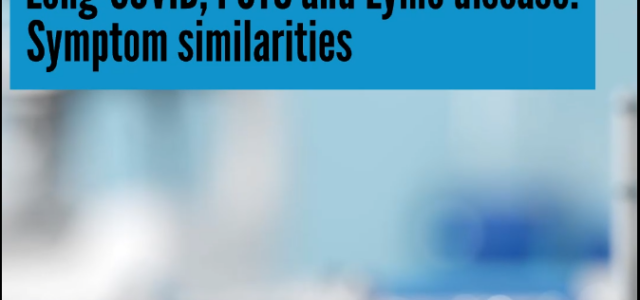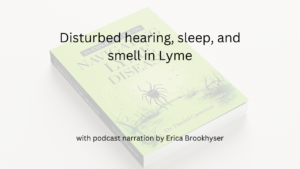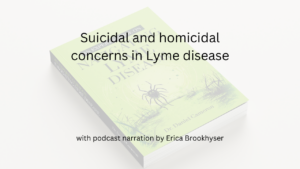Call for your appointment today 914-666-4665 | Mt. Kisco, New York

Hello, and welcome to another Inside Lyme Podcast. I am your host Dr. Daniel Cameron. In this podcast, I will discuss the American Autonomic Society’s statement on Long-COVID postural tachycardia syndrome.
The statement was published in the journal Clinical Autonomic Research by Raj and colleagues.¹
CLICK BELOW TO WATCH VIDEO PODCAST
“Commonly described symptoms of Long-COVID include some combination of breathlessness, palpitation, chest discomfort, fatigue, pain, cognitive impairment (“brain fog”), sleep disturbance, orthostatic intolerance, peripheral neuropathy symptoms (pins and needles, and numbness), abdominal discomfort, nausea, diarrhea, joint and muscle pains, symptoms of anxiety or depression, skin rashes, sore throat, headache, ear ache, and tinnitus,” wrote the authors.
They added, “These symptoms, when combined with excessive orthostatic tachycardia, can lead to a diagnosis of postural tachycardia syndrome (POTS) post-COVID-19.”
POTS and other autonomic disorders after COVID-19 infection were described in a case series of 20 patients.2
Kanjwal and colleagues described a 36-year-old woman. “Our patient recovered from an acute COVID-19 infection and, three weeks to four weeks later, she began experiencing symptoms of fatigue, orthostatic palpitations, chest pain, lightheadedness, headache, and presyncope.” That was confirmed with an abnormal TILT table. She improved with a combination of ivabradine together with increased water and salt intake.3
Ivabradine, marketed under the name Corlanor in the USA, is a heart-rate-lowering agent that selectively and specifically inhibits the cardiac pacemaker current (If).4
The pathophysiology of the Long-COVID POTS remains unclear. “There is also increased incidence of acute motor and sensory axonal neuropathy (AMSAN) and acute demyelinating inflammatory demyelinating polyneuropathy (AIDP) associated with COVID-19, both of which may have autonomic dysfunction as a component.”1
Acute motor and sensory neuropathy and chronic inflammatory demyelinating polyneuropathy (CIDP) have been reported in Lyme disease.5,6
The authors questioned whether patients with Long-COVID POTS were different from patients with POTS unrelated to COVID-19. The authors note that POTS has occurred after a viral illness. Postural tachycardia syndrome, more commonly referred to as Postural Orthostatic Tachycardia Syndrome (POTS), has been described in Lyme disease.7
In addition, the authors questioned whether there are enough physicians experienced in treating POTS. The waiting lists for doctors treating POTS can be six months or longer. There have been similar concerns as to whether there are enough physicians experienced in treating Lyme disease.
Finally, the authors highlighted the need to find better treatments for Long-COVID. Midodrine, a peripheral alpha-adrenergic agonist, has been used in other conditions.8 Fludrocortisone is a synthetic adrenal steroid, has also been used.9 Antibiotic treatments have helped POTS in Lyme disease patients.7
This Inside Lyme podcast episode addresses the following questions:
- What is Long COVID?
- What is POTS?
- How is POTS diagnosed?
- What is a motor and sensory axonal neuropathy?
- What is inflammatory demyelinating polyneuropathy
- What is the autonomic nervous system?
- What is Corlanor?
- What are the treatments for POTS?
Thanks for listening to another Inside Lyme Podcast. Please remember that the advice given is general and not intended as specific advice to any particular patient. If you require specific advice, please seek that advice from an experienced professional.
Inside Lyme Podcast Series
This Inside Lyme case series will be discussed on my Facebook page and made available on podcast and YouTube. As always, it is your likes, comments, and shares that help spread the word about this series and our work. If you can, please leave a review on iTunes or wherever else you get your podcasts.
References:
- Raj SR, Arnold AC, Barboi A, et al. Long-COVID postural tachycardia syndrome: an American Autonomic Society statement. Clin Auton Res. Jun 2021;31(3):365-368. doi:10.1007/s10286-021-00798-2
- Blitshteyn S, Whitelaw S. Postural orthostatic tachycardia syndrome (POTS) and other autonomic disorders after COVID-19 infection: a case series of 20 patients. Immunol Res. Apr 2021;69(2):205-211. doi:10.1007/s12026-021-09185-5
- Kanjwal K, Jamal S, Kichloo A, Grubb BP. New-onset Postural Orthostatic Tachycardia Syndrome Following Coronavirus Disease 2019 Infection. J Innov Card Rhythm Manag. Nov 2020;11(11):4302-4304. doi:10.19102/icrm.2020.111102
- Tse S, Mazzola N. Ivabradine (Corlanor) for Heart Failure: The First Selective and Specific I f Inhibitor. P T. Dec 2015;40(12):810-4.
- Gogia B, Rocha Cabrero F, Rai PK. Chronic Inflammatory Demyelinating Polyradiculoneuropathy. StatPearls. 2021.
- Dimachkie MM, Barohn RJ. Chronic inflammatory demyelinating polyneuropathy. Curr Treat Options Neurol. Jun 2013;15(3):350-66. doi:10.1007/s11940-013-0229-6
- Kanjwal K, Karabin B, Kanjwal Y, Grubb BP. Postural orthostatic tachycardia syndrome following Lyme disease. Cardiol J. 2011;18(1):63-6.
- McTavish D, Goa KL. Midodrine. A review of its pharmacological properties and therapeutic use in orthostatic hypotension and secondary hypotensive disorders. Drugs. Nov 1989;38(5):757-77. doi:10.2165/00003495-198938050-00004
- Rahman M, Anjum F. Fludrocortisone. StatPearls. 2021.



